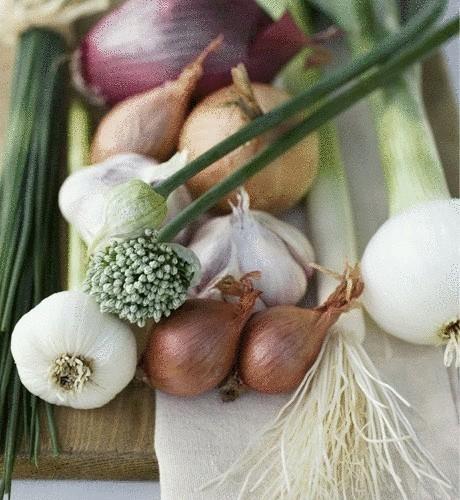524
The 3 most popular food in the middle Ages
In the middle ages the food was a status symbol, depended on how people cook, how they ate and what ingredients are used. In the popular book Melita Adamson Food in Medieval Times (Food in the middle Ages) are very laid out, how to eat medieval man, his understanding of correct diet and those restrictions, which they followed in order to be healthy.
Five million three hundred sixty two thousand eighty four
Then coffee was not yet in Vogue, and the potatoes were not introduced into Europe from America.
As it turned out, in those days, onion and garlic played a key role in cooking and in medicine. The attitude towards them was even better than the beans.
They came to Europe from Central Asia through the middle East.
Garlic
Twelve million seven hundred seven thousand two
In ancient Egypt and Greece, garlic was valued very highly, especially to those people who worked hard physically, and soldiers. It was believed that it had magical powers for warding off evil spirits. In Ancient Rome, some members of the upper classes rejected the garlic because of its strong smell. In the middle Ages garlic was spread through Europe and became used as one of seasonings to food. Came from the South of France garlic dressing used by modern cooks. Since ancient days, garlic was known for its medicinal properties as a means "all diseases". It was believed that it helps in headaches and even snake bites. Those who could not afford a lot of rare and expensive components for the preparation of an antidote, which are then mixed with honey, is recommended as a means of poisonous bites just eat garlic. Garlic was used as a prevention of the plague. For warming and drying impact it in the body, it was believed that it invokes lust.
Лук
According to historical sources, the onion was known in Egypt over 3200 years before Christ. He was popular in the cookery of the Ancient world. Since his mouth smells no matter, it was considered a food of the underclass who ate it and in raw and in processed form.
Members of the lower classes of the middle Ages also ate onions. It was eaten in combination with meat of wild and cultivated farm animals, as well as added to various sauces, soups and stuffing. Recipes of some dishes require the use of only certain varieties of onions, such as shallots.
Medieval doctors as a whole approved the use of onions in food for its warming and diuretic effect. It was believed that the bow contributes to the spermatogenesis and increases the appetite for food and love. However, in society it is widely believed that eating raw onion in food causes abdominal pain and headaches, has a stimulating effect.
Leek
The taste of the leek the more delicate and sweet than normal onions. He was famous even in antiquity. It is believed that a large number of recipes with leeks were in the Roman cookbook Apicius, for the reason that this plant is much liked by the Emperor Nero.
The Romans spread the leeks until Britain, and in the middle Ages it was cultivated and eaten throughout Europe. Dietary quality of the leek, according to medieval doctors, like those of onions. To reduce the volume of gases formed them in the body, recommended to boil the leeks twice, and after the first boiling change the water. published
Ninety two million one hundred seven thousand four hundred ninety seven
Source: rodovid.me
Five million three hundred sixty two thousand eighty four
Then coffee was not yet in Vogue, and the potatoes were not introduced into Europe from America.
As it turned out, in those days, onion and garlic played a key role in cooking and in medicine. The attitude towards them was even better than the beans.
They came to Europe from Central Asia through the middle East.
Garlic
Twelve million seven hundred seven thousand two
In ancient Egypt and Greece, garlic was valued very highly, especially to those people who worked hard physically, and soldiers. It was believed that it had magical powers for warding off evil spirits. In Ancient Rome, some members of the upper classes rejected the garlic because of its strong smell. In the middle Ages garlic was spread through Europe and became used as one of seasonings to food. Came from the South of France garlic dressing used by modern cooks. Since ancient days, garlic was known for its medicinal properties as a means "all diseases". It was believed that it helps in headaches and even snake bites. Those who could not afford a lot of rare and expensive components for the preparation of an antidote, which are then mixed with honey, is recommended as a means of poisonous bites just eat garlic. Garlic was used as a prevention of the plague. For warming and drying impact it in the body, it was believed that it invokes lust.
Лук

According to historical sources, the onion was known in Egypt over 3200 years before Christ. He was popular in the cookery of the Ancient world. Since his mouth smells no matter, it was considered a food of the underclass who ate it and in raw and in processed form.
Members of the lower classes of the middle Ages also ate onions. It was eaten in combination with meat of wild and cultivated farm animals, as well as added to various sauces, soups and stuffing. Recipes of some dishes require the use of only certain varieties of onions, such as shallots.
Medieval doctors as a whole approved the use of onions in food for its warming and diuretic effect. It was believed that the bow contributes to the spermatogenesis and increases the appetite for food and love. However, in society it is widely believed that eating raw onion in food causes abdominal pain and headaches, has a stimulating effect.
Leek
The taste of the leek the more delicate and sweet than normal onions. He was famous even in antiquity. It is believed that a large number of recipes with leeks were in the Roman cookbook Apicius, for the reason that this plant is much liked by the Emperor Nero.
The Romans spread the leeks until Britain, and in the middle Ages it was cultivated and eaten throughout Europe. Dietary quality of the leek, according to medieval doctors, like those of onions. To reduce the volume of gases formed them in the body, recommended to boil the leeks twice, and after the first boiling change the water. published
Ninety two million one hundred seven thousand four hundred ninety seven
Source: rodovid.me























